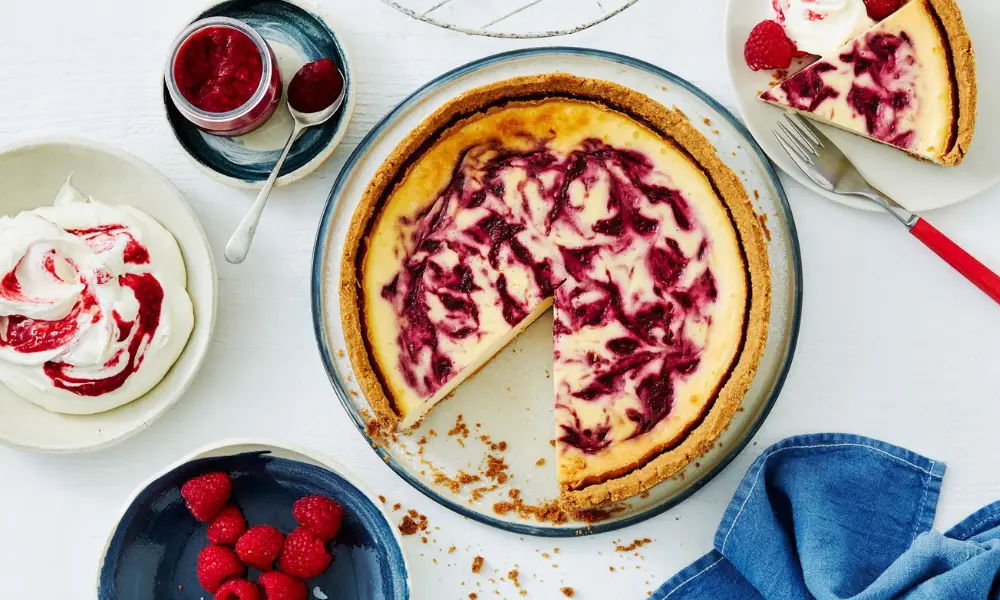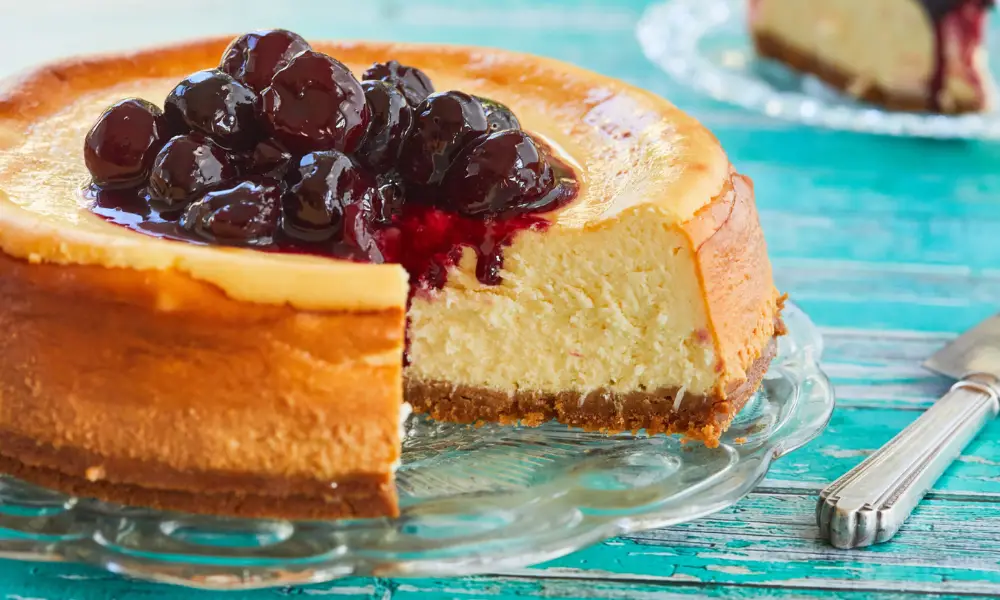Planning is necessary since a classic cheesecake always tastes and feels better the day after baking. Sometimes it’s helpful to prepare dessert well in advance, such as when you’re hosting a party and need to cross something off your list.
Making cheesecake requires a lot of work. Fortunately, it freezes beautifully; creating cheesecake in the freezer feels like money in the bank. After letting it thaw for a few hours, you’ll have an instantly stunning dessert.

Cheesecake
A cheesecake is a baked dessert with a biscuit crust on the bottom and cream cheese, egg, and sugar topping on top. Desserts that don’t require baking or refrigeration are also popular.
The modern cheesecake as we know it was created in the United States of America sometime in the early 1900s after the discovery of cream cheese in 1872, even though prototypes of the dish date back to ancient Greek culture.
Arnold Reuben, a restaurateur and the creator of the Rueben sandwich, is credited with creating the “New York Cheesecake.” The cake quickly gained popularity, giving rise to variant flavours of it.
The most often consumed cheesecake is the New York-style cake, which has a cookie crust and a creamy middle made of eggs, cream cheese, and sugar. Cheesecakes can be flavoured with blueberry, raspberry, blackberry, mango, strawberry, lemon, and other fresh fruit mixtures in addition to chocolate.
How Long Can You Freeze Cheesecake?
Once frozen, cheesecake slices are best eaten within a few months. The cheesecake can be stored for up to four months, but the longer it’s stored, the more the chances of it freezing and developing freeze burn. It’s also best not to leave it in the freezer for more than a month since it’s likely to lose moisture and turn soggy. Thawing the slice on the counter can cause bacterial growth.
- If you’d prefer, you can slice the cheesecake into pieces, leave it whole, or put it on a piece of cardboard and wrap it tightly with foil and then plastic wrap.
- For best flavour, freeze for no more than two months.
- Unless the packaging label specifies a shorter term, store-bought cheesecake has a shelf life of 5 to 7 days in the refrigerator.
- You shouldn’t typically store homemade cheesecake in the fridge for more than five days. Or less time if the recipe you follow calls for it or if there are specific ingredients that must be used quickly.
- Freezing cheesecake is the best option if you need to keep it fresher for longer, and the cake should remain in good condition in the freezer for at least a few months.
- You can freeze cheesecake whole or in slices. If you’re preserving it for a gathering, freeze it intact for an elegant dessert that will be ready when guests come—keeping everything frozen for yourself? No criticism intended—freeze the slices separately for even simpler nibbling.
How to Freeze Cheesecake?
First Step: Allow Cheesecake to Cool
- Allow cheesecake to cool before freezing completely.
- It could be tempting to skip a step and immediately put your cheesecake in the freezer after it comes out of the oven. It won’t set, though, and the consistency won’t be right.
- Your cheesecake should cool to room temperature after baking. Once it has been set, could you put it in the refrigerator?
Second Step: Cut and Wrap
It’s time to prepare your cheesecake for the freezer after it has completely chilled. The cheesecake should be cut into separate slices before being carefully wrapped in plastic and frozen. Place the entire cake on a plate or cardboard circle, and then wrap it in plastic wrap if you plan to freeze it.
Third step: Wrap in Foil
Wrap it once more in foil after the plastic wrap has been removed. Continue until every slice is securely covered. (Or two if you’re not picky about quality control) Freeze for up to a month.
When you’re ready to eat, defrost the cheesecake overnight in the refrigerator or for around 2 to 4 hours at room temperature. You can go ahead and add any toppings once it has thawed.
How Can Cheesecake be Defrosted?
Although defrosting cheesecake is simple, it takes some time, and there isn’t a method to make the procedure go faster. Just give yourself enough time to let the cheesecake gradually defrost.
- Remove Foil: Take your cheesecake from the freezer and peel off the protective foil covering. To safeguard it, leave the cling film on.
- Refrigerate: Please keep it in the refrigerator Place the cheesecake in the refrigerator and let it sit there all night. The next day, your cheesecake should be ready to be removed from the fridge.
- Add a Topping: Do so before serving.
However, if you need your cheesecake a bit more quickly, you may skip the fridge and let it thaw out at room temperature on the kitchen side. This method yields the most outstanding results with the least amount of texture and flavour alteration.
At room temperature, a cheesecake of typical size will defrost in two to four hours.
How to Recognize a Bad Cheesecake?
- Unfortunately, it’s difficult to determine whether cheesecake has gone sour.
- You should throw something out if it has mould, is discoloured, or has a bad smell. However, those symptoms typically appear two weeks after storing the cake.
- The safest course of action is to throw away any handmade cheesecake you keep for longer than 5 to 7 days and any store-bought cheesecake after 7 to 9 days. Yes, even if it appears to be okay.
How Long does it Take a Slice of Cheesecake to Defrost?
We’ve all engaged in it and frozen a few slices of our favourite chocolate chip cookie dough cheesecake so we can enjoy it whenever the urge arises. And the good news is that defrosting a slice of cheesecake is far simpler than defrosting an entire cheesecake, and it can be defrosted in the microwave for under a minute or left on the counter for around two hours. Your decadent, creamy dessert is now ready for consumption.
Is Cheesecake Healthy?
Foods are frequently not produced for health reasons; our texture should be moderately appreciated. Cheesecake, like other sweets like ice cream and pie, isn’t something you should eat for its nutritional worth.
Although cheesecake contains minerals like protein, calcium, and selenium, it should not constitute a significant portion of your diet because it is high in calories, fat, and sugar.
This does not, however, mean that cheesecake must be avoided. Most diets can accommodate small portions of any dessert, even cheesecake.
If you occasionally indulge in cheesecake while maintaining a generally nutrient-dense eating habit, it won’t significantly affect your health.
Conversely, overindulging in sweets like cheesecake can impair your health and raise your risk of developing the disease.
It is recommended to reduce your intake of these items and swap them out with nutrient-dense foods like fruits, vegetables, and legumes if your diet is predominantly made up of foods and beverages like cheesecake, candy, soda, and ultra-processed snack foods.
This can lower your risk of developing diseases like type 2 diabetes and obesity that are connected to eating too many calories and added sugar.
What are the Health Benefits of Cheesecake?
Cheesecake is not healthy food, to be honest. It contains many calories; a 100-gram piece can have over 300. Sugar, salt, and saturated fat levels are high. Your risk of cardiovascular problems may arise if you regularly eat cheesecake. 10 grammes of saturated fat, or 50% of your daily need, can be found in one slice.
However, eating cheesecake has one benefit: it contains protein. Due to the presence of cream cheese and eggs in the cake, 6 grammes of protein, or 13% of your daily need, may be found in it. This benefit can be increased if the cheesecake is made using healthy ingredients like fat-free cream cheese and egg whites, and these clever substitutions can lower the cholesterol content.
Another food that is regarded as healthful is cream cheese. Cream cheese is high in fat but has vitamins A, B12, E, and K. Cheesecake’s essential micronutrients and flavonoids can be provided if it is served with fresh fruits and compotes. The advantages of cheesecake are listed below.
- A good source of protein may improve skin health or vision
- Excellent protein source The essential cheesecake components are cream cheese and eggs, both of which are high in protein. Therefore, cheesecake can provide up to 12% of your daily protein needs in a single meal.
- Possibly suitable for eyesight, Vitamin A, a micronutrient essential for eye health, may be found in cream cheese and egg yolk concentrations. It shields the eyes from age-related macular degeneration.
- Cream cheese includes vitamin E, a micronutrient that guards the skin against ageing and oxidative damage, which may enhance skin health.
What are Some Facts About Cheesecakes?
One of the world’s most unique sweets is cheesecake, perhaps. Other sweets don’t have as wide regionally diverse varieties and descriptions as these. As a result, what you may think of as the perfect cheesecake may not be the same for someone else on the other side of the globe.
Although wheat and flour are not typically found in all modern cheesecake recipes, they were essential to the original Greek recipe. It is believed that later American versions of the dessert, which eliminated the wheat flavour and created an entirely new type of dessert, helped to improve this aspect of the situation.
Some say that New York makes the only authentic cheesecake, which shows how proud the city’s pride inert version is! As we’ve seen, cheesecake can originate from many sources!
In ancient Greece, cheesecake was a widely used wedding and ceremonial cake. Even today, couples might choose to serve these desserts as their wedding cake. At the very least, it is an intriguing variation on the multi-tiered preference.
Fruit and cheesecakes seem to mix nicely together! While the dessert is typically served with berries and sticky fruits, you may also encounter those who prefer it with mangos and figs. Indeed, why not try being a little adventurous if there is a fruit you haven’t yet tried with?
What is the Calorie Content of Cheesecake?
- Cream cheese comes in various flavours and double-cream, whipped, decent, and flavoured varieties.
- Its nutritional profile, therefore, depends on the unique product and brand.
- Fundamentally speaking, 1 ounce (28 grammes) of natural cream cheese offers:
- 10 percent of the daily value for vitamin A (DV)
- Vitamin B2 riboflavin: 5 percent of the DV
- Grain: 2 grammes
- No fibre, grammes
- Cream cheese has a low carbohydrate and protein content and is high in fat. It has some riboflavin and is a rich source of vitamin A. (vitamin B2).
- Per serving, whipped cream cheese has fewer calories and fat.
Conclusion
We don’t typically associate the word “cheesecake” with being healthy. After all, it is fatty food. However, cheesecake might have some health advantages if created with natural, wholesome ingredients. That doesn’t make cheesecake a healthy food; it only implies that some nutrients are present. Let’s look at some benefits of cheesecake consumption.
Slices of cheesecake that have been frozen are best consumed soon after. The cheesecake can be kept for up to four months, but the longer it is held, the greater the likelihood that it will freeze and get freeze burn. Additionally, it’s better to avoid storing it in the freezer for longer than a month because it could start to lose moisture and get soggy. On the counter, thawing the slice can result in bacterial growth.
